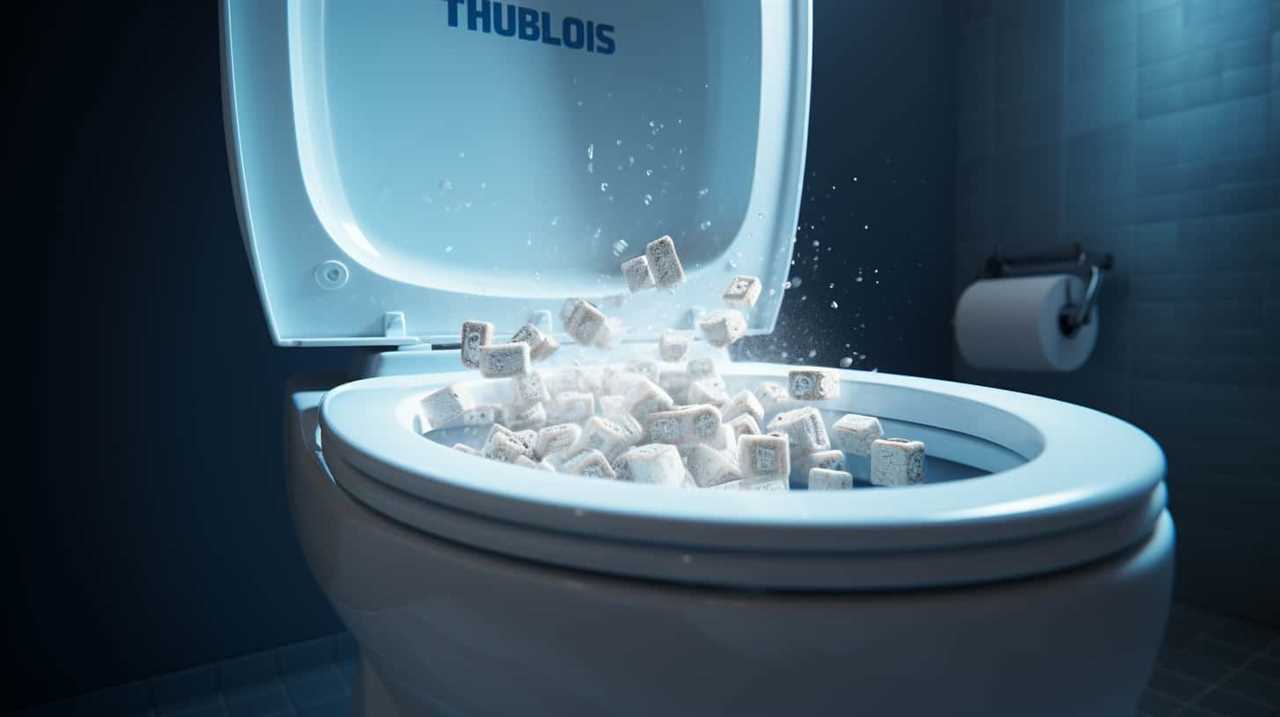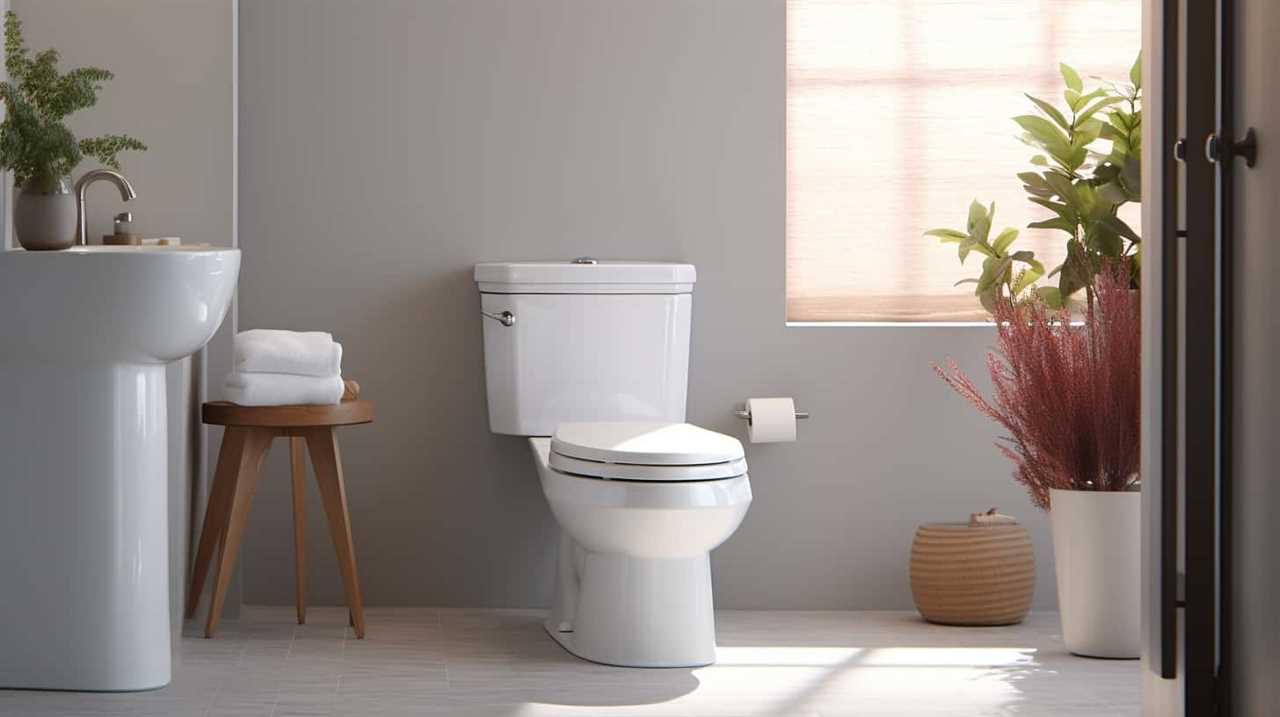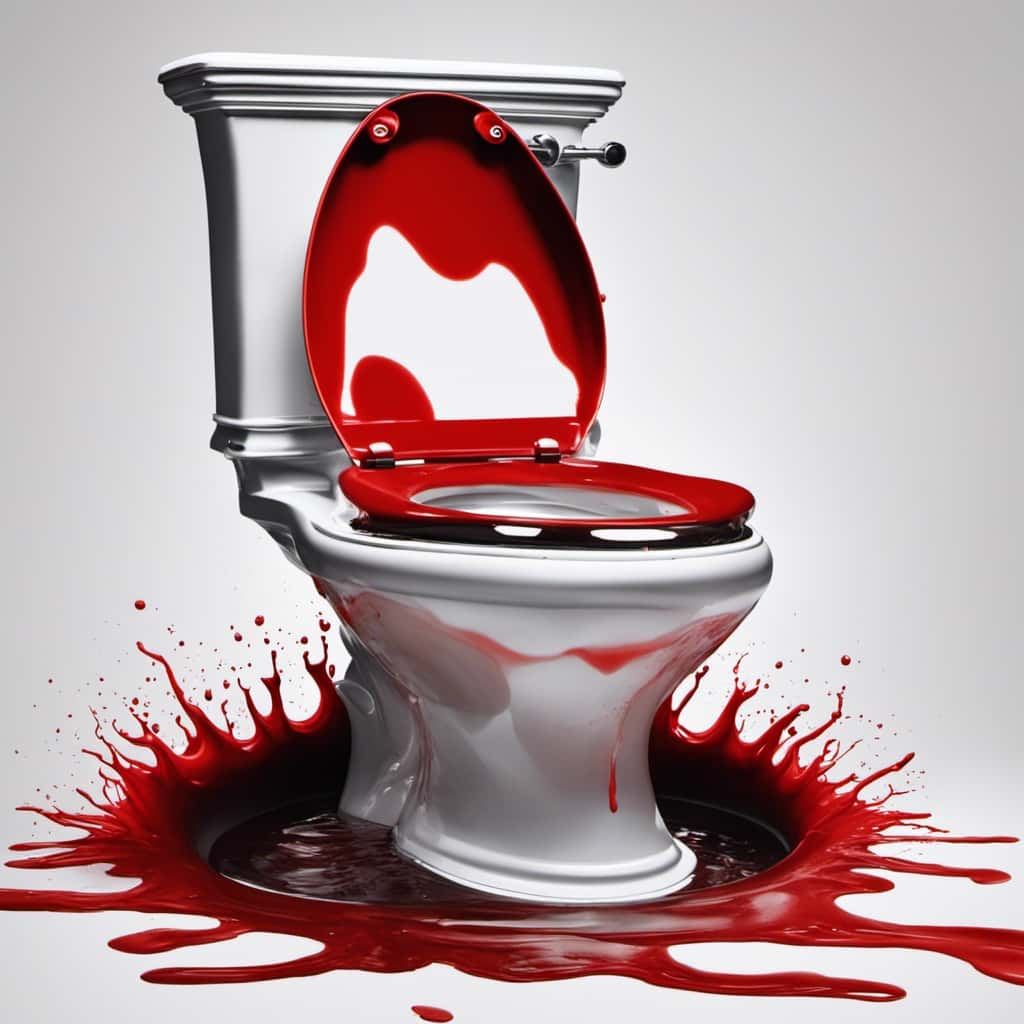Ladies and gentlemen, join us on an adventure to decode the mystery of wet wipes and their perilous voyage through our toilets. Prepare to dive into the realm of plumbing enigmas and uncover precisely how many wet wipes are needed to block a toilet.
With a technical and precise approach, we will arm you with the knowledge needed to prevent this plumbing nightmare. Prepare for a masterclass in toilet clog prevention.
Let the battle begin!
Key Takeaways
- Wet wipes are made from synthetic materials that do not dissolve easily in water, unlike toilet paper.
- Flushed wet wipes can cause blockages in pipes and septic systems due to their durability and resistance to breaking down.
- Wet wipes can get tangled with other materials in the sewer system, leading to backups, flooding, and pipe damage.
- Proper water pressure and disposal of wet wipes in a designated trash can are crucial in preventing toilet clogs and protecting plumbing systems.
Wet Wipes Vs. Toilet Paper: the Battle Begins
As we compare wet wipes and toilet paper, it becomes clear that the battle between the two begins with an understanding of their differences and their impact on our plumbing systems.

Wet wipes, also known as baby wipes or moist towelettes, have gained popularity as an alternative to traditional toilet paper. While bidets offer a water-based cleansing method, wet wipes provide a convenient, disposable option.
However, when it comes to our plumbing systems, wet wipes pose a significant challenge. Unlike toilet paper, wet wipes don’t break down easily in water and can cause blockages in pipes and septic systems. This is because wet wipes are typically made from a combination of synthetic materials, such as polyester and polypropylene, which don’t dissolve like toilet paper.
Understanding the composition of wet wipes will shed light on why they can be problematic for our plumbing systems.
Understanding the Composition of Wet Wipes
Now let’s delve into the composition of wet wipes to better understand why they can cause issues for our plumbing systems.

Wet wipes are typically made from a combination of synthetic fibers, such as polyester or polypropylene, and natural fibers like cotton or bamboo. These fibers are then bonded together using various chemicals, including surfactants, emulsifiers, and preservatives.
While these ingredients give wet wipes their cleaning and moisturizing properties, they also contribute to their durability and resistance to breaking down in water.
This is where the problem arises for toilet hygiene and sustainability concerns. When flushed down the toilet, wet wipes can accumulate in pipes and sewer systems, leading to clogs and blockages.
Understanding the composition of wet wipes allows us to appreciate the challenges they pose for our plumbing systems and the surprising journey of a flushed wet wipe.

The Surprising Journey of a Flushed Wet Wipe
After understanding the composition of wet wipes and the challenges they pose for our plumbing systems, we embark on a surprising journey as we explore what happens when a flushed wet wipe makes its way through the pipes.
The journey of a flushed wet wipe is anything but uneventful, with surprising consequences and long-term effects. Here is a glimpse into this unexpected journey:
- The flushed wet wipe enters the sewer system, where it encounters other debris and waste.
- The wet wipe, due to its non-biodegradable nature, doesn’t break down easily like toilet paper.
- It can get tangled with other materials, forming a conglomeration that impedes the flow of wastewater.
As the wet wipe continues its journey, it may accumulate more debris and solidify over time. This accumulation can lead to the formation of blockages, causing backups and potential flooding. The long-term effects of these blockages can include damage to pipes, increased maintenance costs, and environmental pollution.
With this understanding of the surprising consequences and long-term effects of flushed wet wipes, we now move on to explore what makes wet wipes a potential toilet clogging culprit.

What Makes Wet Wipes a Potential Toilet Clogging Culprit
Wet wipes pose a potential toilet clogging risk due to their non-biodegradable composition and tendency to accumulate with other debris in the plumbing system. Unlike toilet paper, which disintegrates quickly upon contact with water, wet wipes are made from materials like polyester and polypropylene that don’t break down easily. This makes them more likely to snag on rough surfaces or get tangled with other objects, leading to blockages in the pipes.
Toilet clog prevention is essential to avoid plumbing issues and costly repairs. One effective way to prevent wet wipe-related clogs is to dispose of them in a designated trash can instead of flushing them down the toilet. This simple change in behavior can go a long way in maintaining the smooth operation of your plumbing system.
Additionally, there are wet wipe disposal alternatives available on the market. Some brands offer flushable wet wipes that are specifically designed to disintegrate upon flushing, reducing the risk of clogs. However, it’s important to note that even these flushable wipes can still cause issues and should be used sparingly.
The Role of Water Pressure in Toilet Clogs
Water pressure plays a crucial role in toilet clogs. When the water pressure is low, it may not provide enough force to effectively flush away waste and debris, leading to potential clogs.

Alternatively, high water pressure can create a forceful flush that may push objects, such as wet wipes, further into the plumbing system, increasing the likelihood of a clog.
Understanding the impact of water pressure is essential in preventing toilet clogs and maintaining proper plumbing function.
Water Pressure and Clogs
With proper maintenance and regular cleaning, we can prevent toilet clogs caused by excessive water pressure. Understanding the effects of water pressure and following these clog prevention tips can help maintain a functional and efficient toilet system:
- Monitor water pressure: Install a pressure-regulating valve to control the water pressure in your plumbing system.
- Regular inspections: Check for any leaks or blockages in the pipes, as even minor issues can lead to increased water pressure and potential clogs.
- Use low-flow fixtures: Installing low-flow toilets and showerheads can reduce the overall water pressure and minimize the risk of clogs.
- Avoid flushing non-flushable items: Discard items such as wet wipes, feminine hygiene products, and paper towels in the trash instead of flushing them down the toilet.
By implementing these measures, you can effectively manage water pressure and reduce the likelihood of toilet clogs.

Now, let’s explore the impact of pressure on toilet systems.
Impact of Pressure
Toilet clogs caused by excessive water pressure can be a serious issue that we need to address. The impact of pressure on toilet clogs is influenced by several factors, including the temperature of the water and the diameter of the pipes.
High water pressure can increase the likelihood of clogs by pushing waste and debris more forcefully through the pipes. This can lead to blockages and backups in the toilet system.
Additionally, the effect of temperature on pressure can exacerbate the problem. As water temperature increases, the pressure within the pipes can also rise, further increasing the risk of clogs.

Furthermore, the diameter of the pipes plays a crucial role in managing water pressure. Smaller pipe diameters can create higher pressure and increase the chances of clogs.
Therefore, it’s important to consider these factors when evaluating the impact of water pressure on toilet clogs.
Factors That Influence the Number of Wet Wipes to Cause a Clog
When considering the factors that influence the number of wet wipes that can cause a toilet clog, two main points should be addressed.
Firstly, the misconception that flushable wet wipes are truly flushable must be debunked, as they often don’t break down like toilet paper.

Secondly, the diameter of the toilet pipe plays a significant role in determining the number of wet wipes that can pass through without causing a clog.
Understanding these factors is crucial in preventing potential plumbing issues.
Flushable Wet Wipe Misconceptions
Using flushable wet wipes incorrectly can lead to clogs in our plumbing systems. It’s important to debunk some common misconceptions surrounding flushable wet wipes to prevent these issues.
Here are some factors that influence the number of wet wipes that can cause a clog:

- Misleading Labeling: Many wet wipes are labeled as ‘flushable,’ but this doesn’t mean they’ll easily disintegrate in water. In reality, most flushable wipes take a longer time to break down compared to toilet paper.
- Toilet Design: Older toilets with narrower pipes and weaker flushing power are more susceptible to clogs caused by flushable wet wipes.
- Water Flow: Low water flow in the toilet can also contribute to clogs, as it may not provide enough force to push the wet wipes through the plumbing system efficiently.
Toilet Pipe Diameter
Considering the factors discussed earlier, such as misleading labeling and toilet design, it’s important to also consider the diameter of the toilet pipe when determining the number of wet wipes that can cause a clog.
The diameter of the toilet pipe plays a crucial role in the flow of water and waste through the system. A smaller pipe diameter can lead to reduced water flow and increased likelihood of clogs.
Additionally, common toilet pipe problems such as buildup of mineral deposits, tree root intrusion, or blockages caused by foreign objects can further restrict the pipe diameter, making it more susceptible to clogs from wet wipes.
Regular toilet pipe maintenance, including inspection and cleaning, is essential to prevent these issues and ensure proper flow of waste.

The Dangers of Flushing Multiple Wet Wipes
Flushing multiple wet wipes poses a significant risk of clogging the toilet. While wet wipes may seem convenient for personal hygiene, their disposal down the toilet can have dire consequences. Here are the dangers of flushing multiple wet wipes:
- Risk of pipe blockage:
- Wet wipes don’t disintegrate like toilet paper, causing them to accumulate and create blockages in the plumbing system.
- Clogged toilets can lead to overflowing water, potential damage to the bathroom, and the need for costly repairs.
- Environmental impact:
- Flushing wet wipes contributes to sewer blockages and can lead to sewage spills, posing a threat to aquatic ecosystems.
- These non-biodegradable wipes can take years to decompose, exacerbating environmental pollution.
To avoid the dangers of clogged toilets, it’s crucial to dispose of wet wipes properly in the trash. By doing so, we can protect our plumbing systems and the environment from unnecessary harm.
How Wet Wipes Impact Your Plumbing System
How do wet wipes affect our plumbing system?
Wet wipes can have a significant impact on both septic systems and municipal sewer systems. When flushed, wet wipes don’t break down like toilet paper, causing them to accumulate and create blockages in pipes and sewer lines. These blockages can lead to costly and inconvenient plumbing issues, such as clogged toilets, backed-up drains, and even sewer line backups.

Additionally, the impact of wet wipes on septic systems is particularly concerning. Since wet wipes don’t break down easily, they can accumulate in septic tanks, potentially leading to system failures and expensive repairs. Furthermore, flushing wet wipes can pose potential health risks, as they may contain harmful chemicals that can contaminate water sources.
It’s important to be aware of these impacts and avoid flushing wet wipes to protect both your plumbing system and the environment. In the next section, we’ll discuss the signs that your toilet may be clogged with wet wipes.
Signs That Your Toilet May Be Clogged With Wet Wipes
If wet wipes have been flushed down your toilet, there are several signs that indicate your toilet may be clogged with them. These signs include:
- Slow draining: If water takes longer than usual to drain from your toilet bowl, it could be a sign of a clog caused by wet wipes. The wipes can accumulate and obstruct the flow of water, leading to slow draining.
- Gurgling sounds: When you flush the toilet, if you hear gurgling sounds coming from the pipes, it may indicate that wet wipes are causing a blockage. The gurgling sound is caused by the water trying to pass through the clog.
Toilet clog prevention is crucial to avoid these issues. Using eco-friendly hygiene alternatives, such as biodegradable toilet paper or bidets, can help reduce the risk of clogs and minimize environmental impact. By being mindful of what you flush down the toilet, you can prevent costly repairs and maintain a properly functioning plumbing system.

Now, let’s explore the cost of fixing a wet wipe-induced toilet clog.
The Cost of Fixing a Wet Wipe-Induced Toilet Clog
When it comes to the cost of fixing a wet wipe-induced toilet clog, plumbers’ repair expenses can add up quickly. Not only do homeowners have to pay for the plumber’s time and expertise, but they may also need to cover the cost of any necessary parts or equipment.
Additionally, there’s the environmental impact to consider, as clogs caused by wet wipes can lead to sewage backups and contamination of water sources.
Plumbers’ Repair Expenses
After encountering numerous wet wipe-induced toilet clogs, we found ourselves facing significant plumbers’ repair expenses. When it comes to fixing a wet wipe-induced toilet clog, it’s important to understand the expertise required and the costs involved.

Here are the key factors to consider:
- Plumber’s Expertise:
- A skilled plumber possesses the knowledge and experience to accurately diagnose and address the issue.
- They can determine the extent of the clog, identify any underlying problems, and prevent further damage to the toilet and plumbing system.
- Toilet Repair Costs:
- The cost of fixing a wet wipe-induced toilet clog can vary depending on the severity of the clog and the extent of the damage.
- Factors such as labor, replacement parts, and any additional repairs required will contribute to the overall cost.
- It’s crucial to address the clog promptly to avoid more expensive repairs in the future.
Environmental Impact of Clogs
Based on our findings, a significant number of wet wipes can lead to costly repairs and have a negative environmental impact.
The impact of clogs caused by wet wipes goes beyond the inconvenience and expense of calling a plumber. These clogs can result in overflowing toilets, which can cause water damage to floors, walls, and ceilings.
The cost of repairing this damage can be substantial, not to mention the time and inconvenience it causes.

Additionally, wet wipes that don’t break down properly in water can contribute to blockages in sewage systems, leading to backups and overflows in wastewater treatment plants.
This can result in the release of untreated sewage into the environment, contaminating waterways and harming aquatic life.
To prevent these issues, it’s essential to take proactive measures to avoid wet wipe-related toilet clogs.
Tips for Preventing Wet Wipe-Related Toilet Clogs
To prevent wet wipe-related toilet clogs, we recommend using a few wipes at a time instead of excessive amounts. Here are some best practices for toilet clog prevention:

- Proper disposal: Dispose of wet wipes in a designated trash bin instead of flushing them down the toilet. This will prevent clogs and protect the plumbing system.
- Use toilet paper: Use toilet paper for regular wiping and saving wet wipes for specific situations. Toilet paper is designed to break down easily in water, reducing the risk of clogs.
- Educate household members: Teach everyone in your household about the importance of proper wet wipe disposal and the potential consequences of flushing them down the toilet. Awareness and cooperation are key in maintaining a clog-free toilet.
Alternatives to Wet Wipes for Personal Hygiene
For personal hygiene, there are several alternatives to wet wipes that we find effective and convenient. These eco-friendly alternatives are not only better for the environment but also provide the same level of cleanliness. Here are some personal hygiene products that can be used as alternatives to wet wipes:
| Alternatives | Benefits |
|---|---|
| Biodegradable toilet paper | Environmentally friendly and easily disposable |
| Bidet or handheld sprayers | Thoroughly cleans without the need for wipes |
| Muslin cloths or washcloths | Reusable and gentle on the skin |
| Cleansing foam or liquid soap | Effectively removes dirt and bacteria |
The Environmental Impact of Flushing Wet Wipes
As we delve into the environmental impact of flushing wet wipes, it’s important to continue the discussion from the previous subtopic and consider the consequences of this practice on our ecosystems.
Flushing wet wipes, even those labeled as flushable, can have a significant negative impact on wastewater treatment systems. Here are some key points to consider:
- The flushable wet wipes controversy: Despite being marketed as flushable, many wet wipes don’t break down like toilet paper and can cause blockages in pipes and pumps, leading to costly repairs and maintenance for wastewater treatment facilities.
- Effects on wastewater treatment: Wet wipes can clog screens and filters at treatment plants, leading to reduced efficiency and higher energy consumption. Additionally, the non-biodegradable materials in wet wipes can accumulate in sludge and hinder the proper treatment and disposal of wastewater.
Conclusion: Keeping Your Toilet Clog-Free and Plumbing Healthy
Continuing the discussion from the previous subtopic, let’s explore how we can keep our toilets clog-free and maintain healthy plumbing. Preventing clogs is essential not only for the smooth functioning of our toilets but also to avoid the environmental consequences of flushing inappropriate items. Here are some key strategies to keep in mind:

| Preventing Clogs | Environmental Consequences |
|---|---|
| Avoid flushing wet wipes, sanitary products, or other non-biodegradable materials. | Flushing non-biodegradable items can lead to clogs in the sewage system, resulting in increased maintenance costs and potential harm to the environment. |
| Use toilet paper sparingly and ensure it is septic-safe. | Excessive use of toilet paper can contribute to clogs and may require more water for flushing, impacting both plumbing and water conservation efforts. |
| Regularly maintain and inspect your plumbing system. | Identifying and fixing minor plumbing issues early on can prevent major clogs and reduce the risk of environmental damage. |
| Educate household members about proper toilet usage. | Raising awareness about the potential consequences of flushing inappropriate items can help create a responsible and clog-free environment. |
| Consider installing a bidet or bidet attachment. | Bidets provide a hygienic alternative to wet wipes and reduce the need for excessive toilet paper, minimizing clog risks and environmental impact. |
Conclusion
In conclusion, it’s crucial to understand the potential consequences of flushing wet wipes down the toilet. With their non-biodegradable composition and resistance to breaking down, wet wipes can lead to serious plumbing issues and environmental damage.
By opting for more sustainable alternatives and practicing proper disposal methods, we can keep our toilets clog-free and contribute to a healthier plumbing system.
Let’s make responsible choices and prioritize the well-being of our environment.










